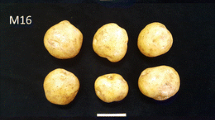Summary
Diploid potato clones selected for their reaction to common scab and their ability to produce 2n male gametes were used in a series of crosses to a susceptible tetraploid female parent (cv. Shepody). In addition, two tetraploid clones were also selected for their reaction to common scab and crossed with Shepody as a female parent. Results indicated that resistance to common scab can be effectively transmitted from the diploid to the tetraploid level via 4x-2x crosses. Diploid parents producing 2n pollen via either first division or second division restitution can be used to transmit scab resistance. A relatively small proportion of resistant individuals could be recovered from susceptible x susceptible crosses in both 4x-2x and 4x-4x combinations. The data support a previously developed hypothesis that scab resistance is relatively simply inherited.
Similar content being viewed by others
References
Alam, Z., 1972. Inheritance of scab resistance in 24-chromosome potatoes. Ph.D. Thesis, Univ. of Wisconsin. 58 p. Diss. Abstr. Int. 32B (12): 6764–6765.
Cipar, M.S. & C.H., Lawrence, 1972. Scab resistance of haploids from two Solanum tuberosum cultivars. Am. Potato J. 49 (3): 117–119.
De, Maine, M.J., L.A., Farrer & M.S., Phillips, 1986. Breeding for quantitative resistance to potato cyst nematode (Globodera pallida) in tetraploid potatoes using dihaploids and unreduced gametes. Euphytica 35: 1001–1006.
De, Maine, M.J., H.E., Stewart & M.S., Phillips, 1989. The production of dihaploids and tetraploids with combined quantitative resistance to potato cyst nematode (Globodera pallida) and foliage blight (Phytophthora infestans). Potato Research 32: 425–430.
De, Maine, M.J., C.P., Carroll, H.E., Stewart, R.M., Solomon & R.L., Wastie, 1993. Disease resistance in Solanum phureja and diploid and tetraploid S. tuberosum x S. phureja hybrids. Potato Research 36: 21–18.
Dionne, L.A. & C.H., Lawrence, 1961. Early scab resistant derivatives of Solanum chacoense x Solanum phureja. Am. Potato J. 38 (1): 6–8.
Frandsen, N.O., 1958. Grundlagen und Methoden der Züchtung. A. Resistenzeigenschaften und ihre Vererbung. 1. Resistenzzüchtung gegen pilzliche und bakterielle Krankheiten der Kartoffel. c. Resistenz gegen Kartoffelschorf, pp. 88–90. In: H., Kappert & W., Rudorf (Eds.). Handbuch der Pflanzenzüchtung, vol. 3. Züchtung der Knollen- und Wurzelfruchtarten. Paul Parey, Berlin and Hamburg.
Herriott, A.B., F.L., Haynes, Jr. & P.B., Shoemaker, 1990. Inheritance of resistance to early blight disease in tetraploid x diploid crosses of potatoes. HortScience 25 (2): 224–226.
Iwanaga, M., P., Jatala, R., Ortiz & E., Guevara, 1989. Use of FDR 2n pollen to transfer resistance to root-knot nematodes into cultivated 4x potatoes. J. Amer. Soc. Hort. Sci. 114 (6): 1008–1013.
King, R.R., C.H., Lawrence, M.C., Clark & L.A., Calhoun, 1989. Isolation and characterization of phytotoxins associated with Streptomyces scabies. J. Chem. Soc., Chem. Commun. 13: 849–850.
King, R.R., C.H., Lawrence & M.C., Clark, 1991. Correlation of phytotoxin production with pathogenicity of Streptomyces scabies isolates from scab-infected tubers. Am. Potato J. 68: 675–680.
Loria, R., 1994. Common and acid scab of potato: management, etiology and potential uses for the phytotoxins produced by Streptomyces species. pp. 149–154. In: G.W., Zehnder, M.L., Powelson, R.K., Janson & K.V., Raman (Eds.). Advances in potato pest biology and management. APS Press, St. Paul, MN, USA.
Schöber, B., 1987. Methoden zur Prüfung der Anfälligkeit von Kartoffelknollen für den gewöhnlichen Schorf (Streptomyces scabies) (Thaxt.) Waksman et Henrici. In: Potato Disease Assessment Keys. EAPR Section for Pathology. Committee for Disease Assessment. 131 p.
Tai, G.C.C., 1994. Use of 2n gametes. In: J.E., Bradshaw & G.R., Mackay (Eds.). Potato Genetics. CAB International, Wallingford, U.K.
Tai, G.C.C., A. Murphy & H. De Jong, 1995. Comparison of efficiency of alternative selection strategies: An example of selection for scab resistance in potatoes (in press).
Tarn, T.R., G.C.C., Tai, H., De, Jong, A.M., Murphy & J.E.A., Seabrook, 1992. Breeding potatoes for long-day temperature climates. Plant Breeding Reviews 9: 217–332.
Wastie, R.L., 1994. Inheritance of resistance to fungal diseases of tubers; common scab, p. 419–421. In: J.E., Bradshaw & G.R., Mackay (Eds). Potato Genetics. CAB International, Wallingford, U.K.
Watanabe, K., H.M., El-Nashaar & M., Iwanaga, 1992. Transmission of bacterial wilt resistance by first division restitution (FDR) 2n pollen via 4x × 2x crosses in potatoes. Euphytica 60: 21–26.
Author information
Authors and Affiliations
Rights and permissions
About this article
Cite this article
Murphy, A.M., De Jong, H. & Tai, G.C.C. Transmission of resistance to common scab from the diploid to the tetraploid level via 4x-2x crosses in potatoes. Euphytica 82, 227–233 (1995). https://doi.org/10.1007/BF00029565
Received:
Accepted:
Issue Date:
DOI: https://doi.org/10.1007/BF00029565




